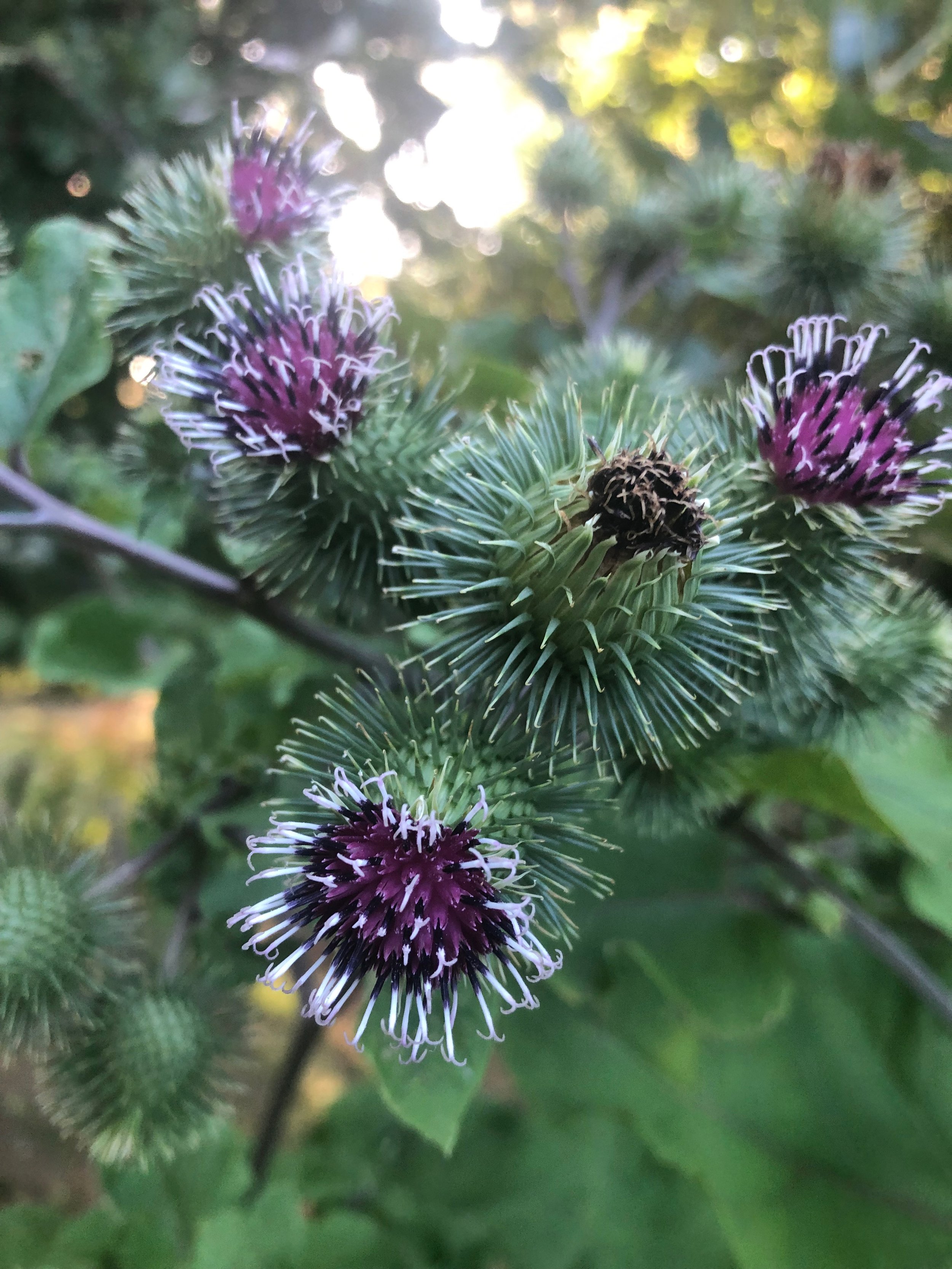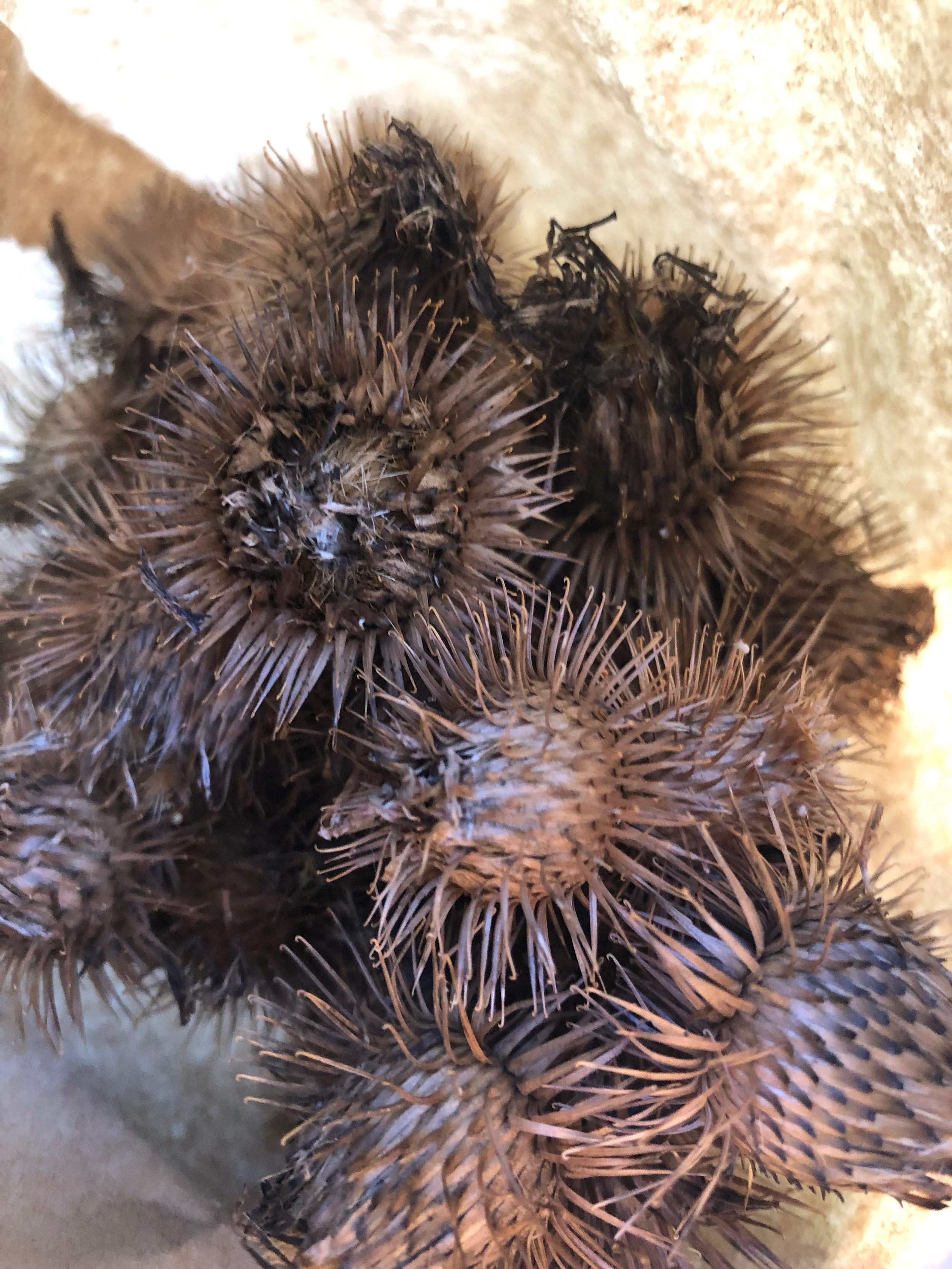 Image 1 of 4
Image 1 of 4

 Image 2 of 4
Image 2 of 4

 Image 3 of 4
Image 3 of 4

 Image 4 of 4
Image 4 of 4





Burdock Seeds
Burdock (Arctium lappa), Gobo burdock, Niu-bang
Description:
Burdock is a robust, biennial herbaceous plant that belongs to the Asteraceae family. It is native to Europe and Asia and has naturalised in many regions around the world. Burdock is well-known for its distinctive appearance, characterised by large, heart-shaped leaves with stalks reaching 3 to 6 feet (0.9 to 1.8m) in height. It features large, coarse, and deeply veined leaves that are often woolly or hairy underneath. The most notable features of burdock is its seed heads, known as burrs, which consist of prickly bracts with hooked spines that easily catch onto clothing and animal fur, aiding in seed dispersal.
Growing Conditions:
Climate: thrives in cool-temperate climates and can tolerate a wide range of conditions; prefers mild summers and cool to cold winters.
Position: full sun to partial shade, with at least 4 to 6 hours of direct sunlight per day; some shade during the hottest part of the day can be beneficial in warmer climates.
Soil: prefers well-draining, loamy soil that is rich in organic matter; tolerates various soil types, including sandy or clay soil, but it thrives in fertile soil with a slightly acidic to neutral pH range (around 6.0 to 7.0).
Water: water regularly, aiming for evenly moist soil; avoid water-logging the soil, as it can lead to root rot; provide irrigation during dry periods or in regions with low rainfall.
Spacing: space the plants approx. 2 to 3 feet (60 to 90 cm) apart to ensure good airflow and prevent overcrowding.
Propagation: sow the seeds directly into the garden bed in early spring or late summer; or into flats, then thin seedlings to at least 6 inches (15cm) apart. Plant the seeds about ½ to 1 inch (1.3 to 2.5 cm) deep and ensure good seed-to-soil contact.
Harvest: typically harvested in late summer through the winter, during the plant's first year of growth. Harvesting at this stage ensures the roots are tender and have not become too fibrous. It is recommended to harvest before the plant enters its second year and begins flowering.
50 seeds per pack
Burdock (Arctium lappa), Gobo burdock, Niu-bang
Description:
Burdock is a robust, biennial herbaceous plant that belongs to the Asteraceae family. It is native to Europe and Asia and has naturalised in many regions around the world. Burdock is well-known for its distinctive appearance, characterised by large, heart-shaped leaves with stalks reaching 3 to 6 feet (0.9 to 1.8m) in height. It features large, coarse, and deeply veined leaves that are often woolly or hairy underneath. The most notable features of burdock is its seed heads, known as burrs, which consist of prickly bracts with hooked spines that easily catch onto clothing and animal fur, aiding in seed dispersal.
Growing Conditions:
Climate: thrives in cool-temperate climates and can tolerate a wide range of conditions; prefers mild summers and cool to cold winters.
Position: full sun to partial shade, with at least 4 to 6 hours of direct sunlight per day; some shade during the hottest part of the day can be beneficial in warmer climates.
Soil: prefers well-draining, loamy soil that is rich in organic matter; tolerates various soil types, including sandy or clay soil, but it thrives in fertile soil with a slightly acidic to neutral pH range (around 6.0 to 7.0).
Water: water regularly, aiming for evenly moist soil; avoid water-logging the soil, as it can lead to root rot; provide irrigation during dry periods or in regions with low rainfall.
Spacing: space the plants approx. 2 to 3 feet (60 to 90 cm) apart to ensure good airflow and prevent overcrowding.
Propagation: sow the seeds directly into the garden bed in early spring or late summer; or into flats, then thin seedlings to at least 6 inches (15cm) apart. Plant the seeds about ½ to 1 inch (1.3 to 2.5 cm) deep and ensure good seed-to-soil contact.
Harvest: typically harvested in late summer through the winter, during the plant's first year of growth. Harvesting at this stage ensures the roots are tender and have not become too fibrous. It is recommended to harvest before the plant enters its second year and begins flowering.
50 seeds per pack
Burdock (Arctium lappa), Gobo burdock, Niu-bang
Description:
Burdock is a robust, biennial herbaceous plant that belongs to the Asteraceae family. It is native to Europe and Asia and has naturalised in many regions around the world. Burdock is well-known for its distinctive appearance, characterised by large, heart-shaped leaves with stalks reaching 3 to 6 feet (0.9 to 1.8m) in height. It features large, coarse, and deeply veined leaves that are often woolly or hairy underneath. The most notable features of burdock is its seed heads, known as burrs, which consist of prickly bracts with hooked spines that easily catch onto clothing and animal fur, aiding in seed dispersal.
Growing Conditions:
Climate: thrives in cool-temperate climates and can tolerate a wide range of conditions; prefers mild summers and cool to cold winters.
Position: full sun to partial shade, with at least 4 to 6 hours of direct sunlight per day; some shade during the hottest part of the day can be beneficial in warmer climates.
Soil: prefers well-draining, loamy soil that is rich in organic matter; tolerates various soil types, including sandy or clay soil, but it thrives in fertile soil with a slightly acidic to neutral pH range (around 6.0 to 7.0).
Water: water regularly, aiming for evenly moist soil; avoid water-logging the soil, as it can lead to root rot; provide irrigation during dry periods or in regions with low rainfall.
Spacing: space the plants approx. 2 to 3 feet (60 to 90 cm) apart to ensure good airflow and prevent overcrowding.
Propagation: sow the seeds directly into the garden bed in early spring or late summer; or into flats, then thin seedlings to at least 6 inches (15cm) apart. Plant the seeds about ½ to 1 inch (1.3 to 2.5 cm) deep and ensure good seed-to-soil contact.
Harvest: typically harvested in late summer through the winter, during the plant's first year of growth. Harvesting at this stage ensures the roots are tender and have not become too fibrous. It is recommended to harvest before the plant enters its second year and begins flowering.
50 seeds per pack